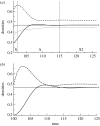The more food webs change, the more they stay the same
- PMID: 19451128
- PMCID: PMC2685426
- DOI: 10.1098/rstb.2008.0273
The more food webs change, the more they stay the same
Abstract
Here, we synthesize a number of recent empirical and theoretical papers to argue that food-web dynamics are characterized by high amounts of spatial and temporal variability and that organisms respond predictably, via behaviour, to these changing conditions. Such behavioural responses on the landscape drive a highly adaptive food-web structure in space and time. Empirical evidence suggests that underlying attributes of food webs are potentially scale-invariant such that food webs are characterized by hump-shaped trophic structures with fast and slow pathways that repeat at different resolutions within the food web. We place these empirical patterns within the context of recent food-web theory to show that adaptable food-web structure confers stability to an assemblage of interacting organisms in a variable world. Finally, we show that recent food-web analyses agree with two of the major predictions of this theory. We argue that the next major frontier in food-web theory and applied food-web ecology must consider the influence of variability on food-web structure.
Figures








Similar articles
-
A landscape theory for food web architecture.Ecol Lett. 2008 Aug;11(8):867-81. doi: 10.1111/j.1461-0248.2008.01193.x. Ecol Lett. 2008. PMID: 18445027 Review.
-
Environmental weakening of trophic interactions drives stability in stochastic food webs.J Theor Biol. 2013 Dec 21;339:36-46. doi: 10.1016/j.jtbi.2013.08.021. Epub 2013 Aug 30. J Theor Biol. 2013. PMID: 23999282
-
Interactive effects of body-size structure and adaptive foraging on food-web stability.Ecol Lett. 2012 Mar;15(3):243-50. doi: 10.1111/j.1461-0248.2011.01733.x. Epub 2012 Jan 26. Ecol Lett. 2012. PMID: 22276597
-
Linking structure and function in food webs: maximization of different ecological functions generates distinct food web structures.J Anim Ecol. 2016 Mar;85(2):537-47. doi: 10.1111/1365-2656.12484. Epub 2016 Feb 8. J Anim Ecol. 2016. PMID: 26749320
-
Food Web Structure in Temporally-Forced Ecosystems.Trends Ecol Evol. 2015 Nov;30(11):662-672. doi: 10.1016/j.tree.2015.09.001. Trends Ecol Evol. 2015. PMID: 26452520 Review.
Cited by
-
Developing a broader scientific foundation for river restoration: Columbia River food webs.Proc Natl Acad Sci U S A. 2012 Dec 26;109(52):21201-7. doi: 10.1073/pnas.1213408109. Epub 2012 Nov 28. Proc Natl Acad Sci U S A. 2012. PMID: 23197837 Free PMC article. Review.
-
Predation by a ciliate community mediates temperature and nutrient effects on a peatland prey prokaryotic community.mSphere. 2025 Jul 29;10(7):e0030925. doi: 10.1128/msphere.00309-25. Epub 2025 Jun 27. mSphere. 2025. PMID: 40576356 Free PMC article.
-
Simulating eutrophication in a metacommunity landscape: an aquatic model ecosystem.Oecologia. 2019 Feb;189(2):461-474. doi: 10.1007/s00442-018-4319-8. Epub 2018 Dec 6. Oecologia. 2019. PMID: 30523402 Free PMC article.
-
Adaptive migration promotes food web persistence.Sci Rep. 2019 Sep 2;9(1):12632. doi: 10.1038/s41598-019-49143-8. Sci Rep. 2019. PMID: 31477790 Free PMC article.
-
Strong nutrient-plant interactions enhance the stability of ecosystems.Commun Biol. 2021 Oct 20;4(1):1202. doi: 10.1038/s42003-021-02737-3. Commun Biol. 2021. PMID: 34671095 Free PMC article.
References
-
- Bascompte J., Jordano P. Plant–animal mutualistic networks: the architecture of biodiversity. Annu. Rev. Ecol. Evol. Syst. 2007;38:567–593. doi:10.1146/annurev.ecolsys.38.091206.095818 - DOI
-
- Brown J., Gillooly J.F., Allen P., Savage V.M., West G.B. Towards a metabolic theory of ecology. Ecology. 2004;85:1771–1789. doi:10.1890/03-9000 - DOI
-
- Carnicer J., Abrams P.A., Jordano P. Switching behavior, coexistence and diversification: comparing empirical community-wide evidence with theoretical predictions. Ecol. Letts. 2008;11:802–808. doi:10.1111/j.1461-0248.2008.01195.x - DOI - PubMed
-
- Cebrian J. Role of first-order consumers in ecosystem carbon flow. Ecol. Lett. 2004;7:232–240. doi:10.1111/j.1461-0248.2004.00574.x - DOI
-
- Cebrian J., Latrigure J. Patterns of herbivory and decomposition in aquatic and terrestrial ecosystems. Ecol. Monogr. 2004;74:237–259. doi:10.1890/03-4019 - DOI
Publication types
MeSH terms
LinkOut - more resources
Full Text Sources

